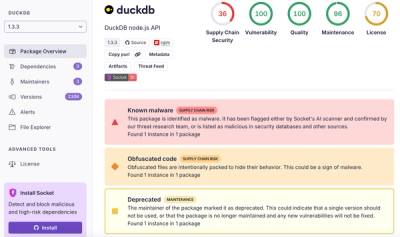
Research
/Security News
DuckDB npm Account Compromised in Continuing Supply Chain Attack
Ongoing npm supply chain attack spreads to DuckDB: multiple packages compromised with the same wallet-drainer malware.
nodespring-eka
Advanced tools
Dependency Injection and Unit Testing for NodeJS using Javascript decorators
NodeSpring is a framework to create NodeJS applications using common patterns used in other programming languages like Java and frameworks like Spring.
$ npm install nodespring
The concepts used by NodeSpring:
Controllers The end points where you deal with HTTP methods (GET, POST, etc.) and invoke the service layer
Services Since you have several modules in your application, it's a good practice to have a service layer where you define the way that those modules are going to communicate each other
Interfaces An interface in NodeSpring is a Javascript class (ES6) where you define methods without business logic, just the definition.
Implementations An implementation is a class that implements all the methods defined on the interface, here is where your business logic should be placed
Unit tests They are Javascript classes (ES6) where you test every single method of your Service/Implementation using the mechanism provided by NodeSpring
Controller:
import {Controller, Get, Post, Inject} from 'nodespring'
import MyUsersService from '../services/MyUsersService'
@Controller
export default class MyClass {
@Inject(MyUsersService)
usersService
@Post({contentType: 'application/json'})
saveObject(object) {
return usersService.saveUser(object)
}
@Get
getUsersList() {
return usersService.getUsersList()
}
}
Service:
import {Service, Inject} from 'nodespring'
import DBService from '../interfaces/DBService'
@Service
export default class MyUsersService {
@Inject(DBService)
dbService
saveUser(user) {
return dbService.saveEntity('Users', object)
}
getUsersList() {
return dbService.getEntityList('Users')
}
}
Interface:
import {Interface} from 'nodespring'
@Interface
export default class DBService {
find(entityType, entity) {}
getEntityList(entityType) {}
}
Implementation:
import {Implements, Inject} from 'nodespring'
import DBService from './../interfaces/DBService'
// import your mongo library
@Implements(DBService)
export default class DBServiceMongoImpl {
saveEntity(entityType, entity) {
return new Promise((resolve, reject) => {
// MongoDB stuff
resolve(response)
})
}
getEntityList(entityType) {
return new Promise((resolve, reject) => {
// MongoDB stuff
resolve(usersList)
})
}
}
Notice that you aren't using MongoDB directly in your service layer, instead, you have a specific implementation to deal with DB operations, if the database engine needs to be changed in the future, you only need to create a new implementation of the interface DBService.
Unit Test:
import {Mock, Test, Before, InjectMocks, TestClass} from 'nodespring'
import MyUsersService from '../services/MyUsersService'
import DBService from './../interfaces/DBService'
@TestClass
export default class MyUsersServiceTest {
@Mock(DBService)
dbServiceMock
@InjectMocks(MyUsersService)
myUsersService
@Before
initTest() {
// stuff before each test
}
@Test
test1(assert) {
this.dbServiceMock.saveEntity = (entityType, entity) => {
// Simulating async behavior
setTimeout(() => {
// You can use all the methods in "assert" npm package
assert.equal(true, true)
// Call done() method to finish the current test like in NodeUnit
assert.done()
}, 5000)
}
}
@Test
test2(assert) {
assert.ok(true)
assert.done()
}
}
There's an example application created by using NodeSpring in this repository:
https://github.com/calbertts/nodespring-example
All of this is in progress, so it can be changed.
FAQs
Dependency Injection and Unit Testing for NodeJS using Javascript decorators
We found that nodespring-eka demonstrated a not healthy version release cadence and project activity because the last version was released a year ago. It has 1 open source maintainer collaborating on the project.
Did you know?

Socket for GitHub automatically highlights issues in each pull request and monitors the health of all your open source dependencies. Discover the contents of your packages and block harmful activity before you install or update your dependencies.

Research
/Security News
Ongoing npm supply chain attack spreads to DuckDB: multiple packages compromised with the same wallet-drainer malware.

Security News
The MCP Steering Committee has launched the official MCP Registry in preview, a central hub for discovering and publishing MCP servers.

Product
Socket’s new Pull Request Stories give security teams clear visibility into dependency risks and outcomes across scanned pull requests.